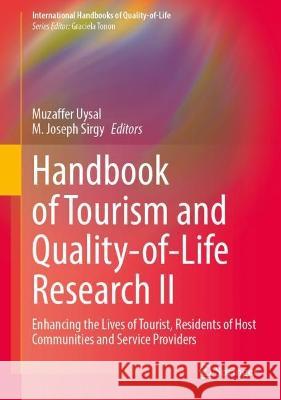Handbook of Tourism and Quality-of-Life Research II: Enhancing the Lives of Tourist, Residents of Host Communities and Service Providers » książka
Handbook of Tourism and Quality-of-Life Research II: Enhancing the Lives of Tourist, Residents of Host Communities and Service Providers
ISBN-13: 9783031315121 / Angielski
Handbook of Tourism and Quality-of-Life Research II: Enhancing the Lives of Tourist, Residents of Host Communities and Service Providers
ISBN-13: 9783031315121 / Angielski
(netto: 883,85 VAT: 5%)
Najniższa cena z 30 dni: 886,75
ok. 22 dni roboczych
Bez gwarancji dostawy przed świętami
Darmowa dostawa!
The second volume of this handbook develops on and extends the discussion in the successful first volume, published in 2012. This is a timely addition to the literature, drawing on the momentum that quality of life (QOL) research in tourism has gained in the 21st century and on the boom in the tourism industry itself. It focuses on four areas of growth in QOL research in the recent past: (1) travelers/tourists, (2) host communities, (3) service providers, and (4) the role of technology. The handbook helps management of tourism firms and policy makers develop specific policies and programs to ensure the most positive impact of tourism on tourists, host communities, and service providers. The comprehensive coverage of topics in this handbook makes it a state-of-the-art reference. Academics interested in QOL research in travel and tourism, tourism practitioners interested in applying the science of QOL in the tourism industry, as well as policy makers involved in regulating the industry will view the handbook as indispensable source of recent research.
The second volume of this handbook develops on and extends the discussion in the successful first volume, published in 2012. This is a timely addition to the literature, drawing on the momentum that quality of life (QOL) research in tourism has gained in the 21st century and on the boom in the tourism industry itself. It focuses on four areas of growth in QOL research in the recent past: (1) travelers/tourists, (2) host communities, (3) service providers, and (4) the role of technology. The handbook helps management of tourism firms and policy makers develop specific policies and programs to ensure the most positive impact of tourism on tourists, host communities, and service providers. The comprehensive coverage of topics in this handbook makes it a state-of-the-art reference. Academics interested in QOL research in travel and tourism, tourism practitioners interested in applying the science of QOL in the tourism industry, as well as policy makers involved in regulating the industry will view the handbook as indispensable source of recent research.











